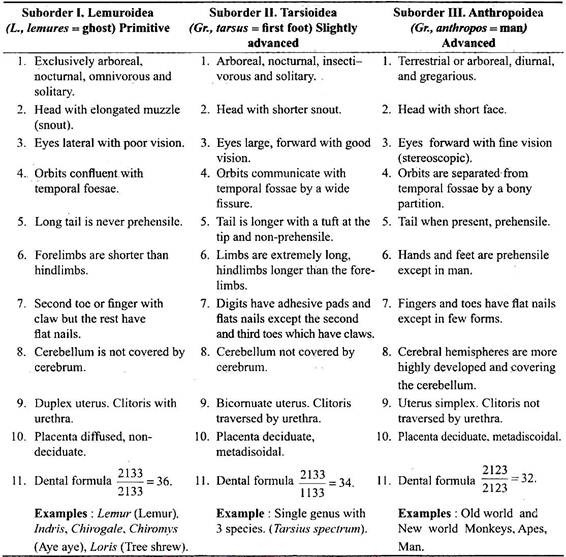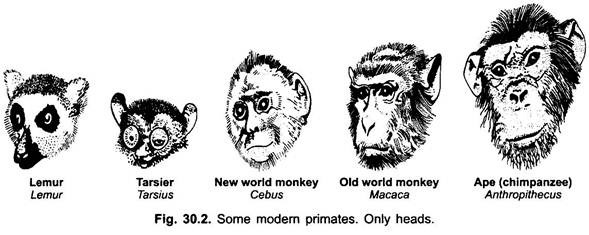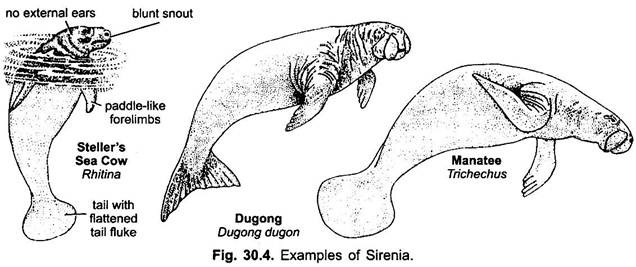In this article we will discuss about the characters and classification of mammals.
Characters of Mammals:
The mammals (Gr., mammae = mammary glands) are at the top of the animal kingdom and are undoubtedly derived from the reptilian subclass Synapsida, most probably from mammal-like reptiles, the Therapsids.
The transition from primitive reptiles to early mammal-like forms occurred in between Upper Carboniferous and the end of the Triassic but they suffered a setback in Permian. In Jurassic only a few small mammals existed but in Cretaceous these small forms became abundant and later on from them in early of Tertiary a number of different types of mammals arose which became perfect.
Therefore, the Tertiary period is known as the age of mammals. Thereafter, mammals have radiated, adapted and colonised almost all parts of the globe in different ecological conditions.
ADVERTISEMENTS:
However, the mammals are characterised by the following features:
Distinguishing Characters:
1. The body is usually covered with hairs which are epidermal in origin.
2. Warm-blooded or ectothermal or homoiothermal animals.
3. The skin is provided with sebaceous, sweat, scent, and milk-glands. The milk-glands produce milk for the nourishment of the young for some time after birth. Only due to the possession of milk-glands and mammae the name mammalia has been derived for this group of animals.
ADVERTISEMENTS:
4. Tail is generally long and mobile.
5. Two pairs of pentadactyle limbs present which are adapted variously for walking, running, climbing, burrowing, swimming or flying.
6. Skull is provided with two occipital condyles, i.e., dicondylic skull. The toes are usually provided with horny claws, nails, hoofs or fleshy pads in aquatic forms.
7. Cervical vertebrae usually seven. Usually external ear or pinna with external auditory meatus present. The pinna may be reduced or absent in burrowing and aquatic forms.
ADVERTISEMENTS:
8. The lower jaw is reduced to a single bone, the dentary, which articulates with the squamosal.
9. Both the jaws are provided with teeth embedded in sockets, i.e., thecodont. Only two sets of teeth are recognised during the lifetime, the deciduous or milk teeth which are replaced by the other set called permanent teeth. This condition is known as diphyodont.
10. The teeth are usually differentiated into four types depending upon their feeding habits, i.e., heterodont. However, teeth are rarely absent.
11. The nasal passage is usually long and mobile.
12. The middle ear is provided with three ear ossicles, the malleus, incus, and stapes.
13. The tongue is usually mobile.
14. The eyes are provided with mobile lids.
15. Heart four chambered, aortic arch asymmetrical, i.e., only left aortic arch present.
16. Respiration occurs by lungs and usually a larynx with vocal cords present. A muscular transverse partition, the diaphragm, separates the body cavity into an anterior thoracic cavity and a posterior abdominal cavity.
ADVERTISEMENTS:
17. The erythrocytes are more, spherical and non-nucleated (except in camel).
18. Brain well developed and specialised with different centres like memory, learning, etc.
19. Males are with a copulatory organ, the penis, and the testis situated outside the abdominal cavity in a scrotal sac (except in aquatic mammals and elephant).
20. Fertilisation internal. Usually viviparous.
21. The development of the embryo occurs in the uterus of the mother where a placenta is formed by the association of uterine and foetal tissues. The placenta helps the embryo in the physiological exchange of materials from the maternal blood and, thus, it brings about nutrition, excretion and respiration, etc., of the embryo in the womb.
General Characters of Mammals:
1. Mammals are hair-clad (except Cetacea), air breathing, warm-blooded oviparous (prototherians) or viviparous animals.
2. The skin has sudoriporous (sweat) glands, sebaceous (oil) glands and sometimes scent glands. Females have mammary glands with teats for nourishing the youngs.
3. Limbs two pairs and are either plantigrade or digitigrade or unguligrade Each limb with five or fewer digits. Cetaceans and sirenians have no hindlimbs.
4. External ears (pinnae) are present.
5. Exoskeleton includes horny, epidermal hairs, spines, scales, claws, nails, hoofs, horns and bony dermal plates.
6. Endoskeleton completely ossified. Skull with two occipital condyles, and is without prefrontals, postfrontals, quadrato-jugal, supraorbitals and basipterygoids. Otic bones fused into periotic which with tympanic forms tympanic bulla.
The lower jaw is composed of a single bone, on each side, the dentary which articulates with squamosal of its side. Vertebrae with terminal epiphyses and centra is acoelous (flat). With few exceptions, mammals possess seven cervical vertebrae. Ribs bicephalous, i.e., with two heads.
7. Presence of a muscular diaphragm between thoracic and abdominal cavities.
8. Alimentary canal without cloaca. Buccal cavity is separated from nasal passage by a hard palate formed of premaxillae, maxillae and palatines. Teeth are heterodont (differentiation into incisors, canines and molars), thecodont (embedded in the alveolar pockets of jaw bone) and diphyodont (only two sets of teeth, a milk set replaced by permanent set).
9. Respiration by lungs (pulmonary). Glottis is guarded by epiglottis. Larynx with vocal cords.
10. Heart is four-chambered with only a left aortic arch. Renal portal system is absent. RBCs are small and non-nucleated, homoiothermous.
11. Brain with four optic lobes. cerebrum and cerebellum are large and convoluted. Corpus callosum connecting both the cerebral hemispheres is present. Cranial nerves 12 pairs.
12. The kidney is metanephros. Ureters open into urinary bladder. Ureotelic.
13. Eyes are protected by lids. Upper eyelids are movable. Middle ear has 3 ear ossicles-malleus, incus and stapes. Cochlea spirally coiled.
14. Sexes separate. Male with erectile penis. Eggs small with very little yolk.
15. Fertilisation is always internal, after copulation.
16. Except monotremes, all are viviporous. The young, except in monotremes, develops in the uterus for some time and born alive.
Classification of Mammals:
Mammals include about 5000 living species and several fossil forms.
Mammals are classified on the basis of:
(1) Mode of caring for their youngs,
(2) Dentition,
(3) Foot posture,
(4) Exoskeleton (nails, claws and hoofs),
(5) Complexity of brain, and
(6) Systematics.
For the purpose of this text, we shall refer only 18 living orders of mammals which are first divided into 2 subclasses:
a. Prototheria and
b. Theria.
G. G. Simplon, recognised 18 living and 14 extinct orders of mammals.
Subclass I. Prototheria:
(Gr., protos = first + therios = beast)
1. No pinna on the ear.
2. In the skull, tympanic bulla and lacrimals are absent; the jugal is reduced or absent.
3. Teeth are present only in young, adults with horny beak.
4. The pectoral girdle possesses large coracoid bones and interclavicle. The pelvic girdle possesses epipubic bones extending from the pelvis. Vertebrae without terminal epiphyses. The ribs have only a single head, the tuberculum being absent. The cervical ribs are present.
5. A cloaca is present into which ureters and urinogenital sinus open.
6. Mammary glands without nipples.
7. There is no corpus callosum in the brain.
8. The cochlea is a simple process of the sacculus and not coiled.
9. Testes are abdominal.
10. Females are oviparous.
11. Found in Australia, Tasmania and New Guines.
Order 1. Monotremata:
(Gr., monos = single + trema = opening)
The general characters are same as that of Prototheria.
Examples:
Echidna (Spiny ant-eater), Ornithorhynchus (Platypus).
Subclass II. Theria:
(Gr., ther= animal)
1. Includes modem viviparous marsupial and placental mammals.
2. Ear usually with external pinna.
3. Mammary glands with nipples or teats.
4. Teeth are usually present both in young and adults. Vertebrae with terminal epiphyses.
5. Cloaca is usually absent.
6. Testes usually in the scrotal sac. Vasa deferentia and bladder opening through a common urethra in penis. Ureters open into the base of bladder.
7. Oviducts open into a vagina. Subclass Theria is divided into two living infraclasses.
Infraclass I. Metatheria:
(Gr., meta = between or after)
1. Marsupium or brood pouch is present in the females.
2. Mammary glands bearing nipples are sebaceous.
3. Epipubic (marsupial) bones are usually present and attached with the pubis. Separate coracoid and interclavicle are absent.
4. Corpus callosum is feebly developed or absent.
5. Vagina and uterus are double (didelphic condition).
6. Placenta is rudimentary yolk sac type.
7. They are confined to Australian region.
Order 1. Marsupialia:
(Gr., marsypion = pouch)
Young ones are born immature and develop in mursupium attached with nipples or teats. In dentition 3 premolar and 4 molars are usually present. Other characters are same as that of Metatheria.
Examples: Didelphis (Opossum), Dasyurus (Tiger cat), Caenolestes, Notoryctes (Marsupial mole), Parameles (Bandicoot), Macropus (Kangaroo), Phascolarctos (Koala).
Infraclass II. Eutheria:
(Gr., eu = true + therios = beast)
1. Higher viviparous placental mammals. Marsupium (marsupial pouch) is entirely absent.
2. Epipubic bones are absent.
3. Cloaca is absent.
4. Corpus callosum is present.
5. Testes are usually contained in scrotal sacs.
6. Vagina is single.
7. The young always nourished for a considerable time in the uteras by means of allantoic placenta and born in a relatively advanced state.
Order 1. Insectivora:
(L., insectum = insect + vorare = to eat)
1. Small and furry animals.
2. Snout usually long and tapering.
3. Feet usually five-toed with claws, inner toe not opposable.
4. Molars sharp and pointed for insects feeding. Dental formula: i 3/3, c 1/1, p 4/4, m 3/3.
5. Placenta discoidal.
6. Noctumal and terrestrial.
Examples: Erinaceus, Paraechinus (Hedgehog), Scapanus, Talpa (Mole), Sorex, Echinosorex (Shrews), Solenodon (Solenodon).
Order 2. Dermoptera:
(Gr., derm = skin + pteron = wing)
1. Commonly known as “flying lemurs.”
2. Furry skin stretched between equal-sized fore- and hindlimbs and the tail, called patagium.
3. Incisor teeth 2/3.
4. Nocturnal in habit.
Examples:
Galeopithecus or Cynocephalus having two species from South-eastern Asia.
Order 3. Chiroptera:
(Gr., cheiros = hand + pteron = wing)
1. Commonly known as true flying mammals or bats.
2. Forelimbs are modified into membranous wings.
3. Hindlimbs are weak and have sharp clawed digits which are included in wing membrane.
4. Eyes are small with vision weak and ears with large pinnae.
5. Teeth are small and sharp. Dental formula- i 2/3, c 1/1, p 3/3, m 3/3.
6. Sternum has a keel.
7. Mostly nocturnal in habit.
Order 4. Primates:
(L., primus = of the first rank).
Primitive mammals with well developed brain. Cerebrum is large and convoluted.
1. Five digits of hand and foot with flat nails.
2. Thumb and great toe are shorter and opposable for grasping.
3. Eyes are directed forward and surrounded by bony ring.
4. Femur has no third trochanter.
5. Mode of walking is plantigrade.
6. Placenta discoidal or metadiscoidal and haemochorial.
This order is divided into three suborders- Lemuroidea, Tarsioidea and Anthropoidea. Anthropoidea is further subdivided into two infraorders- Platyrrhina and Catarrhina.
Order 5. Edentata:
(L., edentetus = toothless)
1. Teeth present or absent, if present, incisors and canines are always absent. Only molars are present.
2. Feet have well developed strong and curved claws.
3. The testes are abdominal.
Examples:
Sloth (Bradypus), Armadillos (Dasypus), American ant-eaters, (Myrmecophaga).
Order 6. Pholidota:
(Gr., pholis = a horny scale)
1. Body covered by large overlapping horny scales.
2. Hairs are sparsely found between the scales.
3. Snout is elongated.
4. Tongue is long, sticky and protrusible.
5. Teeth are entirely absent.
6. Ears are reduced.
7. Limbs are short bearing five digits. Forelimbs have well developed claws.
8. Nocturnal and burrowing in habits.
Example:
Single genus Manis (Pangolin or scaly ant-eater).
Order 7. Lagomorpha:
(Gr., logos = hare + morphe = form)
1. Two pairs of incisors are present in the upper jaw, first pair large and chisel-like found in front of smaller second pair.
2. Tibia is fused with the fibula. Soles of feet are hairy. Toes bear claws.
3. Testes are always external in the scrotum.
Examples:
Oryctolagus (Rabbit) and Lepus (Hare), Ochotona (Pika).
Order 8. Rodentia:
(L., rodo = gnaw)
1. Usually small gnawing mammals.
2. Incisors single pair, long chisel-like, rootless and persistently growing with enamel, confined chiefly to the anterior end. Canines are entirely absent.
3. Space known as diastemma present between the incisors and molars, i.e., at the place of canine.
Examples:
Funambulus (Squirrel), Rattus rattus (House Rat), Mus (Mouse), Hystrix (Porcupine), Cavia (Guinea pig). Castor (Beaver), Cynomys (Prairie dog).
Order 9. Cetacea:
(Gr., ketos, or L., cetus = a whale)
1. Medium sized to very large aquatic mammals.
2. Body is usually fish-like.
3. Hairy covering of skin is reduced to few bristles on the muzzle.
4. Head long often pointed without neck.
5. Eyes are minute. Nostrils on the top of the head and ear openings are minute, without external ears.
6. Forelimbs are modified as paddles, digits are enclosed in a common integument devoid of claws. Hindlimbs are entirely absent.
7. Tail is long ending in two broad, transverse, fleshy flukes notched in the mid-line. It is used in swimming.
8. Fleshy dorsal fin is present in some forms. Dorsal and tail fins have no skeletal elements.
9. A thick layer of fat (blubber) is present beneath the skin.
10. Bones of skull are spongy and contain fat.
11. Stomach is complex and consists of three or four chambers.
12. Testes are abdominal.
13. Placenta is non-deciduate and diffuse.
Examples:
Living catacea is divided into two suborders- Odontoceti (toothed whales) and Mysticeti (Mystacoceti) (wholebone whales).
Order 10. Carnivora:
(L. caro = flesh + vorare = to eat)
1. Small to large quadrepels, terrestrial, arboreal or aquatic, predatory, flesh-eating mammals.
2. Teeth generally have sharp and cutting edges. Canines are large and fang-like for tearing flesh. The incisors are small and always 3 on each side in each jaw. Molars are cutting type.
3. Toes or digits never less than four and all have strong and sharp claws.
Living carnivores are divided into two suborders- Fissipedia and Pinnipedia.
Suborder I. Fissipedia:
1. Terrestrial carnivores having separate toes. Incisors are always six in each jaw and are feebly developed in many cases. Canines are always very large and strong.
2. The last premolar in the lower jaw known as carnassial teeth and the last two molars are crushing teeth.
3. The digits are mostly five and never less than four. All the digits are separate and have claws.
Examples:
Panthera leo (Lion), Panthera tigris (Tiger), Prionalurus bengalensis (Leopard cat), Acinonyx (Hunting leopard). Civet cat, Herpestes (Mongoose), Hyaena (Hyaena), Canis lupus (Wolf), Vulpes (Fox), Canis familiaris (Dog), C. aureus (Jackal), Lutra (Otter), Meles (Badger), Acinonyx (Cheetah), Felis domesticus (Domestic cat), Ursus (Bear), Procyon (Racoon), Mustela (Mink), Ailuropoda (Panda), Mephites (Shunk).
Suborder II. Pinnipedia:
1. Marine carnivores, with torpedo-shaped body.
2. The greater part of the limbs are enclosed within the body skin and hands and feet are fully webbed. Limbs modified into paddles or flippers.
3. Tail is very short, useful in swimming.
4. External ear small or degenerated.
Examples:
Otario jubata (Sea-lion), Trichecus (Walrus), Phoca (Common seal), Callorhinus (Fur seal).
Order 11. Tubulidentata:
(L., tubulus = tube-like + dens = tooth)
1. Body stout, somewhat pig-like.
2. Skin is very thick, covered with sparse hairs.
3. Snout is long and tubular with round nostrils at the tip.
4. Tongue slender and protrusible.
5. Ears are long, erect, and pointed.
6. Milk teeth numerous and permanent teeth only 4 or 5 without enamel and perforated by numerous tubules of pulp.
7. Digits 4 or 5 with heavy claws.
Example:
Single genus Orycteropus (Aard- vark or Cape ant-eater) of South Africa.
Order 12. Proboscidea:
(Gr., pro = in front + boskein = to eat)
1. Largest and highly specialised terrestrial mammals.
2. Skin is thick and sparsely covered with hairs.
3. Long proboscis or trunk which is an elongation of the nose and upper lip, bearing the nostrils at the tip.
4. Eyes are small and ears very large.
5. Legs are large, pillar-like and bear five functional digits with small, nail-like hoofs on both fore-and hindlimbs.
6. Two incisor teeth of the upper jaw developed into great tusks. Canines are altogether absent. Molars are lophodont. Dental formula : i 1/0, c %, p 3/3 m 3/3.
7. Testes are abdominal in position.
Examples:
Elephas maximus (Indian or Asian elephant), Loxodonta (African elephant), Elephas cyclotis (African pygmy elephant) and extinct mammoths and mastodon.
Order 13. Hyracoidea:
(Gr., hyrax = shrew + eidos = form)
1. Small guinea pig-like animals with a split snout.
2. Ears are short and the tail is much reduced.
3. Legs short with four digits in the forelimbs and three in hindlimbs.
4. Testes are abdominal.
5. Dental formula: i 1/2, c 1/0,pm 4/4, m 3/3.
Example:
Procavia or Hyrax (Conies of South Africa).
Order 14. Sirenia:
(Gr., siren = sea nymph)
1. Large, herbivorous, aquatic mammals commonly known as sea cows.
2. Body spindle-shaped with paddle-like fore-limbs. Hindlimbs are absent.
3. Tail flattened with horizontal lateral flukes, with or without notch.
4. Nostrils are on the upper surface of the blunt snout.
5. Few hairs over the body.
6. Stomach complex, consisting of several chambers.
7. Testes are abdominal.
Examples:
Halicore = Dugong (Dugong), Trichechus (Manatees).
Order 15. Perissodactyla:
(Gr., perissos = odd + dactyloss = toes)
1. Large-sized odd-toed hoofed mammals or ungulates. Toes 1 or three.
2. The middle (3rd) digit of fore-and hindlimbs is pre-eminent and carries most of the weight.
3. Teeth are lophodont. Incisors present in both jaws.
4. Stomach is simple.
Examples:
Equas cabalus (Horse), Equus zebra, (Zebra ) Tapirus (Tapir), Rhinoceros or Diceros (Rhinoceros).
Order 16. Artiodactyla:
(Gr., artios = even + dactylos = digit)
1. Terrestrial and semi-aquatic even-toed hoofed mammals.
2. Fore-and hindlimbs bear two, rarely four digits.
3. Teeth are selenodont or bunodont. Incisors and canines in upper jaw are usually absent.
4. Stomach is complicated, 4-chambered.
5. Except pig and peccaries, all chew or ruminate their cud.
Examples:
Hippopotamus (Horse of river), Sus (Pig), Dicotyles (Peccaries), Camelus (Camel), Cervus (Deer), Moschus (muskdeer), Giraffa (Giraffe), Antelope (Blackbuck), Cow, Buffalo, Ovis (Sheep), Capra (Goat), Bos indicus (Ox), Bos grunniens (Yak).





